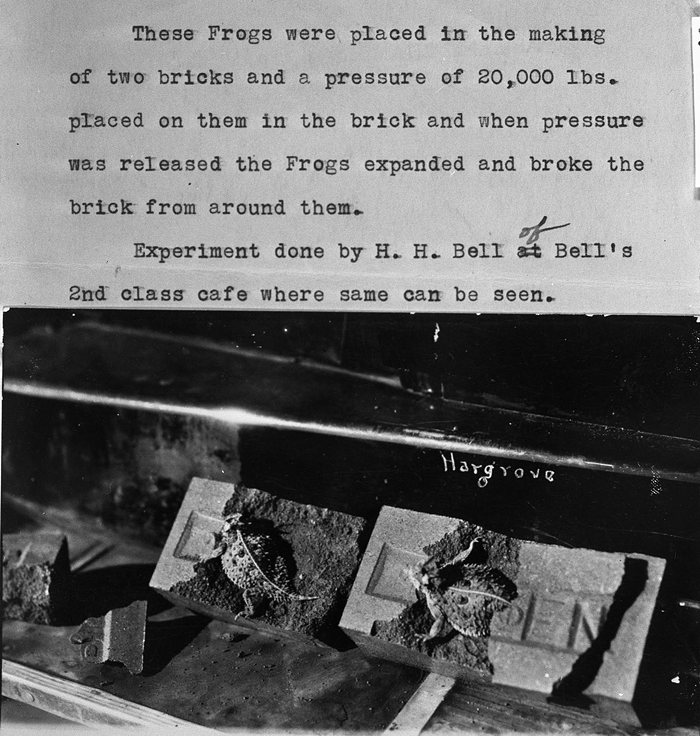The Pressed Frog Phenomenon
I found the image below at the Texas History site of the University of North Texas. It appears there as is, without any further explanation (or date).

I realize that the indentations on top of bricks are called 'frogs', but why were actual frogs being placed inside bricks?
As far as I can tell, it must have been an experimental demonstration of the 'pressed frog phenomenon' — this phenomenon being that one can place a living frog inside a brick as its being made, apply thousands of pounds of pressure to the brick to mold it, and the frog will survive. The frog won't be happy about the experience, but it won't burst. Whereas the same pressure applied to a frog that isn't in a brick will definitely cause it to burst.
Obviously the brick hasn't been heated in a kiln, because that would definitely cook the frog.
The article below from 1925 explains the science of why a frog in a brick doesn't burst. The key part of the (overly long) explanation is this sentence:
However, this doesn't solve the mystery of who first decided to put a frog in a brick.



I realize that the indentations on top of bricks are called 'frogs', but why were actual frogs being placed inside bricks?
As far as I can tell, it must have been an experimental demonstration of the 'pressed frog phenomenon' — this phenomenon being that one can place a living frog inside a brick as its being made, apply thousands of pounds of pressure to the brick to mold it, and the frog will survive. The frog won't be happy about the experience, but it won't burst. Whereas the same pressure applied to a frog that isn't in a brick will definitely cause it to burst.
Obviously the brick hasn't been heated in a kiln, because that would definitely cook the frog.
The article below from 1925 explains the science of why a frog in a brick doesn't burst. The key part of the (overly long) explanation is this sentence:
when the pressure was exerted gradually there was a tendency for the particles of clay around the body to "wall up" the body by the grains of clay moving instead of a tendency of the body "bursting" by the particles of the body moving.
However, this doesn't solve the mystery of who first decided to put a frog in a brick.


Clarion Ledger Sun - Aug 16, 1925
Comments
Just a note: that first picture shows horned lizards not frogs. In some areas of the south and south-west they are known as horned (or horny) toads. But they are not amphibian.
Posted by KD on 05/23/22 at 07:48 AM
Frogs probably put themselves in.
Making slabs for picnic tables in a mostly-rustic park with a large pond -- half the workers teenagers forced by their parents to give up their Saturday, other half people doing court-ordered community service who were such screw-ups that the litter-pick-up crews didn't want them. Constant problem: stopping people from deliberately dumping a shovelful of concrete onto frogs which jumped into the forms. (Project supervisor repeatedly said he didn't give a damn about the frogs, but they'd either work their way out after a slab was troweled or they'd die and rot away, leaving a thin spot which would eventually break, creating a hole.)
It's easy to imagine someone, way back when, making bricks near a stream or pond, having a frog jump into the form, and saying to heck with it and dropping wet clay on them and packing it down.
Making slabs for picnic tables in a mostly-rustic park with a large pond -- half the workers teenagers forced by their parents to give up their Saturday, other half people doing court-ordered community service who were such screw-ups that the litter-pick-up crews didn't want them. Constant problem: stopping people from deliberately dumping a shovelful of concrete onto frogs which jumped into the forms. (Project supervisor repeatedly said he didn't give a damn about the frogs, but they'd either work their way out after a slab was troweled or they'd die and rot away, leaving a thin spot which would eventually break, creating a hole.)
It's easy to imagine someone, way back when, making bricks near a stream or pond, having a frog jump into the form, and saying to heck with it and dropping wet clay on them and packing it down.
Posted by Phideaux on 05/23/22 at 09:06 AM
Am I the only person who can recognize a HORNY TOAD? When did frogs evolve a scaled tail?
Posted by Swordfish Mining on 05/23/22 at 09:08 AM
I have a few books of the "Believe It or Not..." vein that has a couple of those stories where a live (or barely living) frog is found inside a piece of material. I never put any credence into the stories, even when I was ten years old. Maybe there was something wrong with my sense of gullibility.
Posted by KDP on 05/23/22 at 10:43 AM
Did anyone else think of the Warner Brothers cartoon classic, "One Froggy Evening" which featured Michigan J. Frog? It was based on the story of Ol' Rip, a Horned Toad who survived 31 years trapped in a building cornerstone:
https://en.wikipedia.org/wiki/Ol%27_Rip_the_Horned_Toad
https://en.wikipedia.org/wiki/Ol%27_Rip_the_Horned_Toad
Posted by Tall Tom on 05/23/22 at 10:47 AM
Commenting is not available in this channel entry.



Category: Animals | Science | Experiments | 1920s